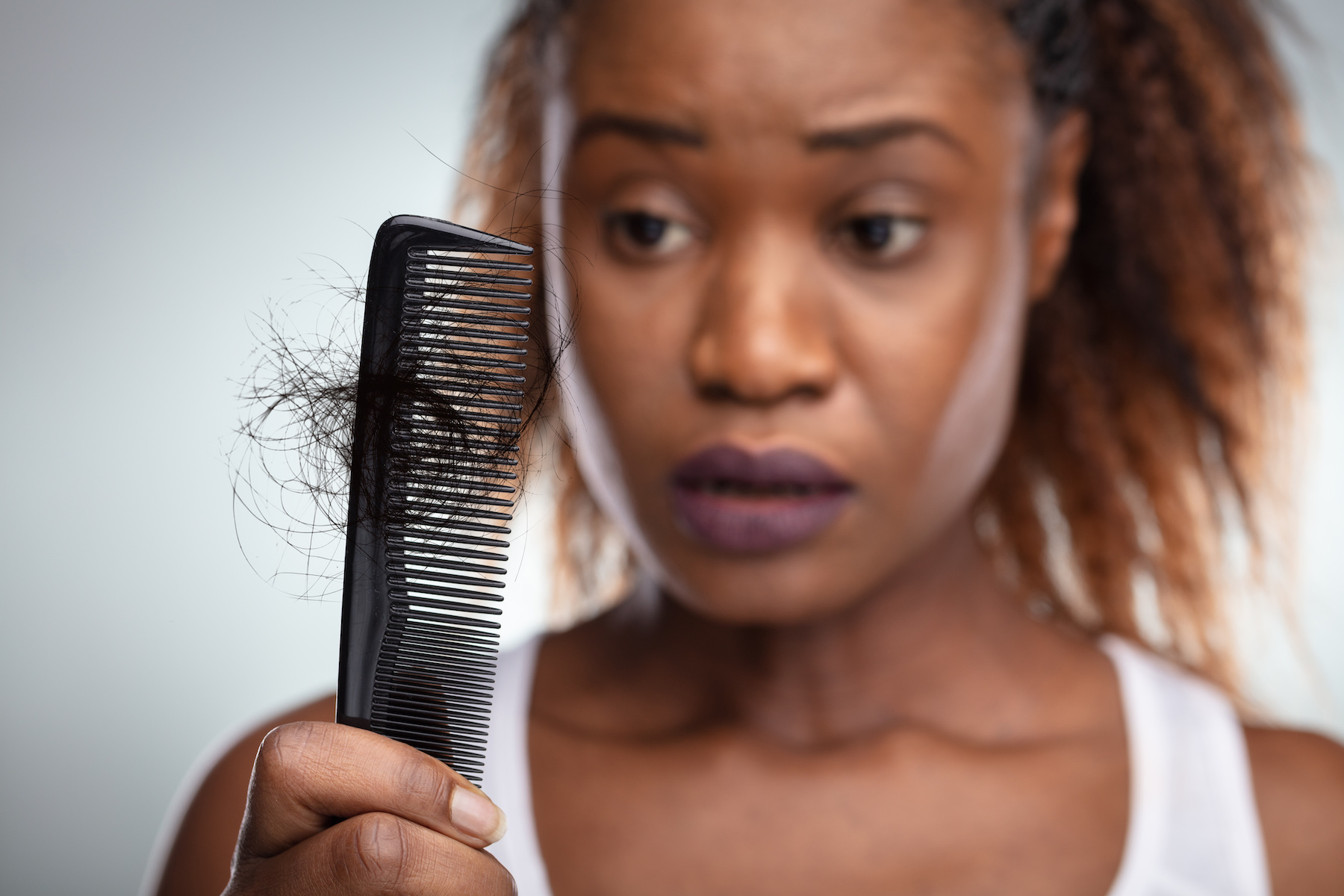

Hair loss is a disorder that most people think only men experience but, in reality, 50% of women do too!
Hair loss is also known as alopecia.
Each day, we lose about 50 to 100 hairs, but a healthy individual will be able to regenerate those that have fallen out without leaving a bald spot, receding hairline, or patch of thinning hair. If you notice these symptoms and the treatments you’re using aren’t helping you to get better, it’s time to seek help – after all, nobody wants to experience hair loss.
Traditional medicine doctors will likely give you a prescription like minoxidil and/or a steroid without fully looking into the root cause or causes. They are only treating the symptoms but not the actual reason for hair loss. Functional medicine practitioners are different. We understand that what’s happening to you is a sign that something else in your body may be off-balance. There IS a root cause to your hair loss, and it’s our mission to determine what that is.
So, what does normal hair growth look like anyway?
What causes hair loss?
What can you do to treat your hair loss?
Let’s explore the answers to these questions in this blog post.
The Normal Hair Growth Cycle and How It Works
The normal hair growth cycle occurs in four different phases: the anagen, catagen, telogen, and exogen phases. If you’re experiencing hair loss, this normal cycle will be interrupted.
Cycle 1: The Anagen Phase (Hair Growth)
The anagen phase is the longest and lasts about 2-7 years, depending on where your hair is located. Hair on your scalp takes much longer to grow than shorter hairs like hair on your legs and eyebrows.
About 80-90% of the hair on your scalp is in this growing phase. Your hair follicle, the sac where hair growth happens, forms a new hair shaft. Your hair follicles will push out the hair that continues to grow until the hair is cut or reaches the end of its lifespan and falls out.
Cycle 2: The Catagen Phase (Transition)
The catagen phase occurs when the anagen phase ends and lasts about three weeks. Your hair follicles shrink, hair growth slows, and hair separates from the bottom of the follicle. The hair remains in place until the next phase. Only 1-2% of your hair is in this phase at a time.
Cycle 3: The Telogen Phase (Resting Phase)
The telogen phase lasts about 3 to 4 months. Your hair is in this resting phase about 10-15% of the time.
Cycle 4: The Exogen Phase (Shedding Phase)
In a healthy individual, at the end of the telogen phase, the hair falls out (sheds), and new hair begins growing in the same hair follicle.
Hair loss is a normal part of your hair growth cycle. But when this cycle is interrupted, and you’re unable to grow new hairs, this can lead to symptoms and signs like:
- Clumps of hair falling out as your brush your hair
- A receding hairline that gets worse
- Bald spot slowly growing
- Gradual hair thinning
- Widening of hair part
- Thin ponytail
Dealing with these symptoms can be FRUSTRATING. But there’s hope! Hair loss is usually a sign your body sends to let you know something else is wrong. Keep reading to learn the common causes of hair loss.
What Causes Hair Loss?
While this list doesn’t describe all of the reasons you may be experiencing hair loss, I see these seven common causes in my practice. Let’s explore them a bit.
1. Nutrient deficiencies (Especially Biotin, Zinc, and Iron)
Nutrient deficiencies are one of the biggest contributors to hair loss I see in my patient population. Your body needs nutrients for follicular development, hormone regulation, and immune function to occur. Some common nutrients that are seen low in patients dealing with hair loss include biotin, zinc, and iron. Other contributors like low vitamin D, and a low protein diet may be factors as well.
- Biotin: Biotin is also known as vitamin B7 and helps your body metabolize carbohydrates, proteins, and fats. It also regulates your genes’ activity and cell signaling. Patients with low levels of biotin typically experience hair loss and/or skin and nail problems. By taking biotin, symptoms improved.
Now, biotin has been glamorized as a supplement for hair loss. However, some reports have shown inconclusive results, especially if the patient already has an adequate level of biotin. This is why you should visit a doctor to determine if a biotin deficiency causes your hair loss.
Some biotin food sources include cooked eggs, salmon, grass-fed beef liver, sweet potato, nuts, and seeds.
- Zinc: Zinc is a mineral that your body can’t generate on its own. So zinc has to be supplied by your diet. Hair loss is a common side effect of zinc deficiency, and hair regrowth occurs when zinc is taken. In addition, zinc is a cofactor for thyroid health, which can be a contributing factor as well (see more below). Common food sources for zinc include oysters, red meat, poultry, chickpeas, and nuts.
- Iron: Your body needs iron to make hemoglobin and as well as some of your hormones. Hemoglobin is an essential part of red blood cells that carries oxygen. This oxygen is used for the growth and repair of cells, including those that are used to stimulate hair growth.
Your thyroid also uses iron to produce its hormones. For example, your thyroid needs iron to produce your thyroid hormone T3 (triiodothyronine). If there’s a disruption in thyroid hormone production, this affects the development of hair follicles at the root. You may experience hair loss.
Your body uses ferritin to store iron. Ferritin will release iron when your body needs it. I highly recommend that women with menstruation, gluten intolerances, anemia, and gut health issues get their ferritin and iron levels checked. They may not be absorbing iron from the foods they’re eating, leading to hair loss.
In addition, your cells’ mitochondria also need iron to create ATP as an energy source for your cells.
If you’re experiencing hair loss, your doctor can determine which blood tests and nutrients need to be measured to see what you’re deficient in. Your doctor will also need to rule out if you’re dealing with other health and/or gut problems that could be preventing you from properly absorbing the nutrients your body needs.
2. Stress (HPA axis dysfunction)
Hair loss can happen in people triggered by stress or a shock to their bodies, such as childbirth, surgery, high fever, illness, or psychological stress. This is because of telogen effluvium: stress causes your hair roots to be pushed prematurely into the telogen or resting state.
While only about 5-10% of our hair is in the resting state, about 30% of your hair is in the resting state when you have telogen effluvium. It can be acute, where excess shedding resolves itself in about 6 to 12 months, or chronic, where hair loss can continue for years. The only way to treat chronic telogen effluvium is to identify the cause of the stress trigger.
3. Thyroid
Hair loss is one of the most common signs of an underactive thyroid (aka hypothyroidism, when your body isn’t producing enough crucial hormones). You may experience dry, brittle, and thinning hair. Sometimes, the outer third of your eyebrow also sheds.
Your body needs thyroid hormones for many functions, including metabolism and hair and nails health. It’s important that your doctor tests for thyroid-stimulating hormone, free T3, free T4, total T4, total T3, reverse T3 and a thyroid antibody tests. Your body needs T4 because it converts it to T3 (active thyroid hormone). Low T4 levels can lead to low T3 which manifests in symptoms like hair loss. There are of course several factors that can slow down proper conversion from T4 to T3, like nutrient deficiencies, dietary changes, inflammation, stress, and toxins for example.
Once you get your test results back, your doctor will help you determine which treatment is best for you if you have an underactive thyroid.
4. Sex Hormone Dysfunction (Especially From High Levels of DHT)
While thyroid hormones play a massive role in the hair growth cycle, your sex hormones do too. The sex hormone testosterone uses an enzyme 5-alpha reductase to create dihydrotestosterone (DHT), an androgen hormone used by your hair follicles. Androgens give males their biological characteristics, but women also have DHT in their bodies (just at lower amounts).
While studies still need to be done to show precisely why DHT and testosterone play a huge role in hair loss, some theories exist. DHT seems to be essential for hair growth on other parts of the body, but higher than normal levels can contribute to hair loss on your head.
DHT attaches to androgen receptors in your hair follicles which could lead to hair loss. Genetics seems to play a significant role since some people have increased DHT receptors at their hair follicles or produce larger amounts of DHT than others.
Other hormone imbalances such as those associated with estrogens may contribute as well. A drop in estrogen such as after pregnancy and in menopause may contribute to thinning hair. In addition, other hormones like progesterone, prolactin, and DHEA can also influence the hair follicle.
In general, male and female sex hormone imbalances are commonly due to improper or poor detoxification. Just like there’s an “expiration date” for your fruits and vegetables, your hormones have one too. When your hormones aren’t active anymore, their parts need to be removed from your system. If your body can’t remove the old or expired hormones, this can lead to hormone metabolism imbalance with symptoms like hair loss.
5. Environmental Toxins
You’re surrounded by a sea of environmental toxins, so it’s important for your body to be able to get rid of these toxins. Toxins like BPA from your plastic water bottle or pesticides from your food can lead to changes in your gut microbiome, insulin resistance, and other hormone disruptions leading to hair loss.
Other environmental toxins from air pollution and radiation can also irritate your scalp and cause hair loss. Some toxins can even cling to your hair shaft and cause damage. Your doctor may ask you a series of lifestyle questions or perform testing to see if you’ve been exposed to a high amount of environmental toxins.
6. Genetics
Unfortunately, if you have a family member who experiences hair loss, you could be susceptible due to your genes. It’s the most common cause of hair loss worldwide. Androgenetic alopecia is inherited hair loss where your anagen cycle (hair growth cycle) becomes shorter. Your hair follicles also grow hair that’s thinner than normal. Eventually, your hair follicles shrink and stop producing hair.
Hair loss from genetics can occur in both males and females and can be inherited from both parents. Men usually see hair loss at their hairline and the top of their heads. Women will typically notice hair loss at the top of their heads.
7. Autoimmune disease
It’s possible that your immune system can mistakenly attack your hair follicles. When this happens, you have alopecia areata. It’s common in people younger than 20 but can also occur at any age. Your hair follicles enter the telogen phase (resting phase) too soon.
Hair loss can occur on your head but also other parts of your body. It’s important to work with your doctor to see which autoimmune disease may be triggering hair loss.
As you can see, hair loss isn’t a one-size-fits-all approach. There are many reasons why you can be experiencing hair loss. In some cases, you could be experiencing hair loss from more than one of the reasons listed above. It’s imperative to work with a functional medicine provider to determine the root cause of your hair loss. This way, you receive the treatment that will work best for your condition. I’ll explore several treatments that have helped my patients next.
What Are Treatments for Hair Loss?
While hair loss can be challenging to deal with, I want you to know that there are treatments to help you get your hair growth back to a more normal cycle. After working with a doctor to understand the root cause of your hair loss, here are some treatments to consider:
- Replacing nutrient deficiencies
- Balancing hormones
- Reducing stress
- Reducing toxin exposure
- Getting your autoimmune disorder under control
- Topical treatments such as prescriptions like minoxidil, scalp massages, and specialized serums, shampoos, and conditioners
- Prescription oral medications such as finasteride
- Specialized treatments like PRP and stem cell injections, as well as more invasive procedures like hair transplantation
You might not see results from just choosing a treatment from this list, so it’s essential to work with your doctor to diagnose the root cause first.
What Can You Do if You’re Struggling With Hair Loss?
While hair loss can be embarrassing and frustrating as a male or female to deal with, functional medicine can help you get to the root cause of why you may be losing hair. If you’re looking for a doctor to work with to help and you’re located in Arizona, we are currently accepting patients. You can click this link and fill out the form.
Here’s to getting to the root cause of your hair loss,
Dr. Emily Parke
Share:
Dr. Emily Parke
Related Posts

What Is Sleep Apnea? Symptoms, Risks, and Treatment Options
Sleep apnea occurs when breathing repeatedly stops and starts throughout the night. Learn the symptoms, risks, and sleep apnea treatment options.

Estrogen Metabolism: How It Works, Why It Matters, and Supplements for Healthy Estrogen Metabolism
Estrogen metabolism is vital to estrogen regulation. Learn how it works and how the DUTCH test can provide insight into hormonal imbalance.

The Paleo Diet Versus the Autoimmune Paleo Diet: Differences and Benefits
Learn the difference between the paleo and the autoimmune paleo diet, including food lists, what foods to avoid, and all the health benefits!

A Complete View of Multiple Sclerosis: Symptoms, Diagnosis, and Functional Medicine Treatment Options
Get a complete view of multiple sclerosis, including common symptoms and treatment options, including nutrition and supplementation.
